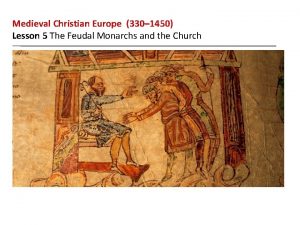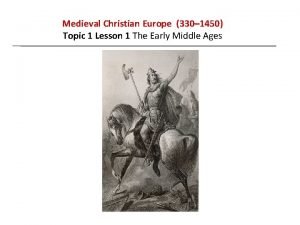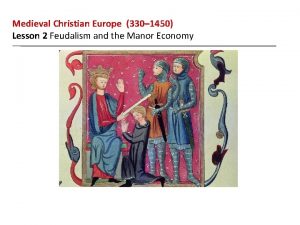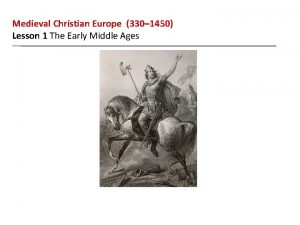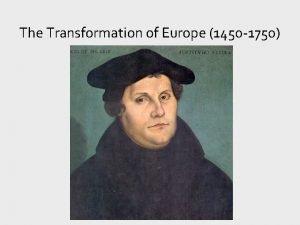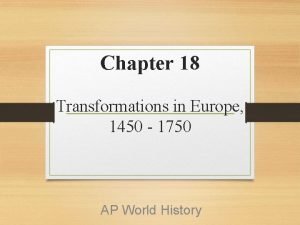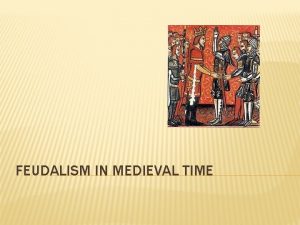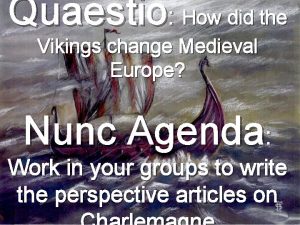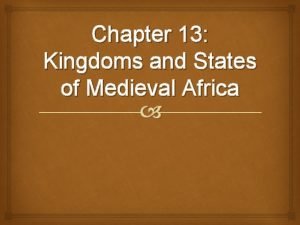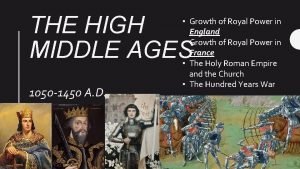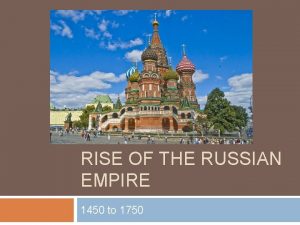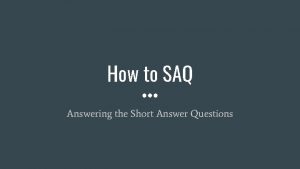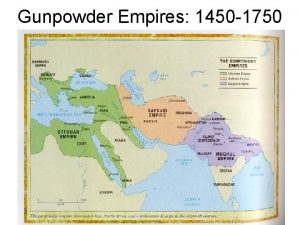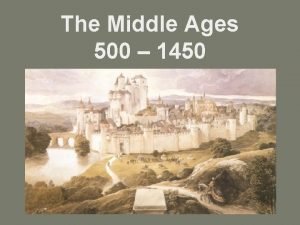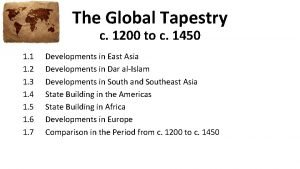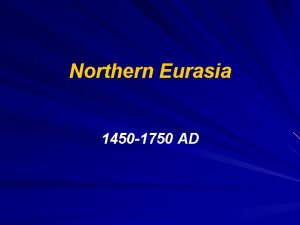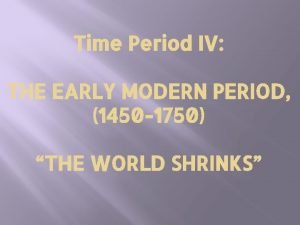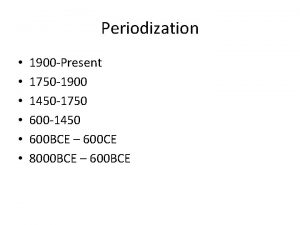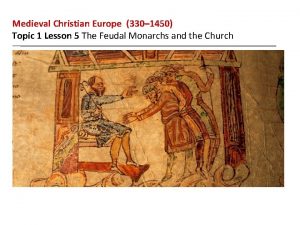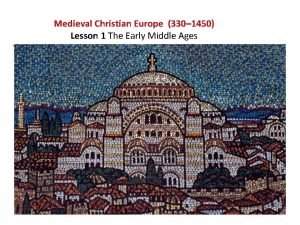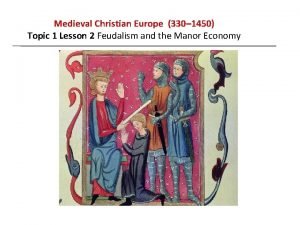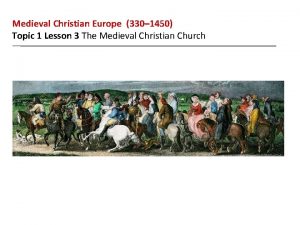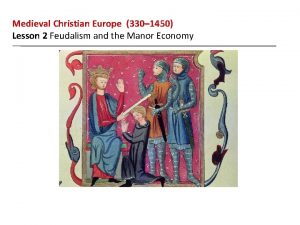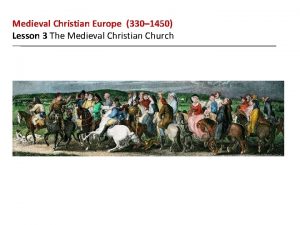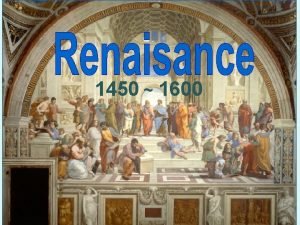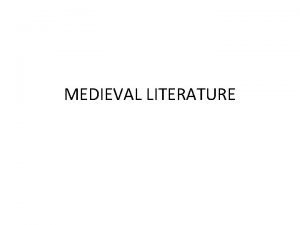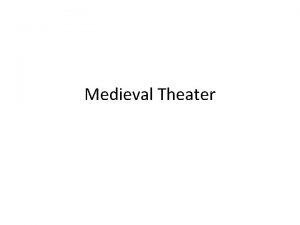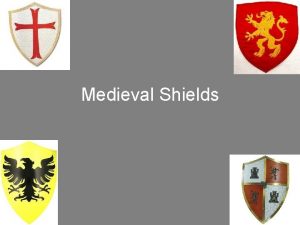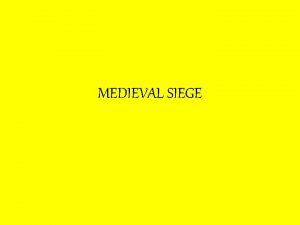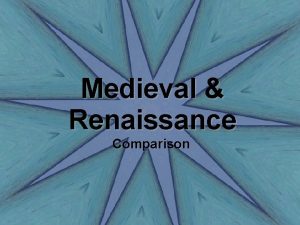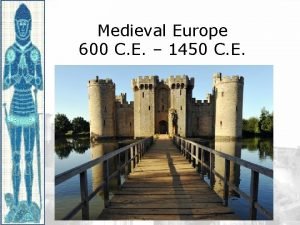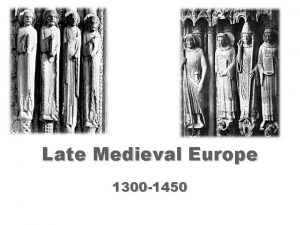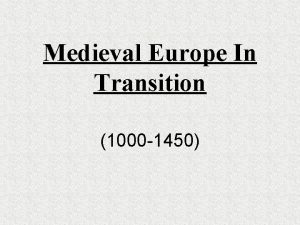Medieval Christian Europe 330 1450 Lesson 1 The





















- Slides: 21

Medieval Christian Europe (330– 1450) Lesson 1 The Early Middle Ages

Medieval Christian Europe (330– 1450) Lesson 1 The Early Middle Ages Learning Objectives • Summarize ways in which the Byzantine empire flourished after the decline of Rome. • Explain the impact of the fall of Rome on Western Europe. • Describe how Germanic tribes carved Europe into small kingdoms. • Explain how Charlemagne briefly reunited much of Western Europe and what happened to his empire after his death.

The Byzantine Empire Thrives In European history, the thousand-year span between the fall of the Roman empire and the Renaissance beginnings of modern history is known as the Middle Ages. Perhaps best remembered today for knights on horseback and towering Gothic cathedrals, this medieval period began with the collapse of the western Roman empire. Constantinople Grows: • Great defensive location, guarded on 3 sides by water • Commanded key trade routes between Europe and Asia • Continued activities from Roman Heritage like chariot racing Blending of Cultures: • Blended Ancient Greek, Roman, Christian traditions with Mediterranean customs

The Byzantine Empire Thrives Major European and Asian trade routes met at Constantinople. Analyze the Maps and summarize Constantinople's protective advantages.

The Byzantine Empire Thrives Constantinople, the wealthy Byzantine capital, rises behind strong walls to the great domes of the church of Hagia Sophia and beyond in this mosaic from London's Westminster Cathedral.

The Age of Justinian The Byzantine empire reached its greatest size under the emperor Justinian, who ruled from 527 to 565. Justinian was determined to revive ancient Rome by retaking lands that had been overrun by invaders. • • • Hagia Sophia Justinian’s Code and Its Impact Justinian Rules With Absolute Power Economic and Military Power The Empire Declines

The Age of Justinian Hagia Sophia first served as a cathedral for more than 900 years, then as a mosque for nearly 500 years. A Turkish museum since 1935, it remains a magnificent presence.

The Age of Justinian

The Age of Justinian The Byzantine empire reached its greatest size by 565. Analyze Maps Describe the Byzantine empire's extent in 1020. Infer What does the empire's size in 565 suggest about Justinian’s rule?

Changes in Western Europe In Europe, the centuries after the fall of Rome are called the Middle Ages, which lasted from about 500 to 1350. The Middle Ages refers to the time between the ancient and modern worlds. During this long stretch of time, Western Europe passed through two distinct phases: the early Middle Ages, lasting from about 500 to 1050, and the late Middle Ages, lasting from about 1050 to 1350. A Shift to the North: Power leaves the Mediterranean and heads to Western Europe Start of the Germanic Tribes A Time of Decline: Learning, and trade decline Population loss due to wars and loss of civilization

Changes in Western Europe Analyze Graphs When does Rome's greatest population drop in thousands occur? the greatest percentage drop? Draw Conclusions What does the information in this graph tell you?

Germanic Kingdoms The Germanic tribes that conquered parts of the Roman empire included the Goths, Vandals, Saxons, and Franks. • • • Their culture was very different from that of the Romans. They were mostly farmers and herders, so they had no cities or written laws. Instead, they lived in small communities governed by unwritten customs. Their kings were elected leaders, chosen by tribal counsels. Warriors swore loyalty to the king in exchange for weapons and a share in the plunder taken from defeated enemies. Between 400 and 700, these Germanic tribes carved Western Europe into small kingdoms.

Germanic Kingdoms The Kingdom of the Franks • In 486 Clovis, King of the Franks, conquered the former Roman province of Gaul • He tried to preserve much of the Roman legacy • He converted to Christianity in order to gain support of his people and the Pope Muslim Armies Advance Into Europe • Islam is founded as a religion in 622 and in the next 200 years create a very large empire. • They take over North Africa, Palestine, and Spain all Christian Kingdoms • They advance into France where they are defeated by Charles Martel at Tours in 732 • They still hold Spain and are distrusted by the Christians even though Muslims share knowledge about Science and Math with the Europeans.

Germanic Kingdoms King Clovis of the Franks rallies his warriors during one of many battles he fought to build his kingdom. His conversion to Christianity set an example for other Germanic rulers.

Charlemagne Builds an Empire In 768, the grandson of Charles Martel became king of the Franks. He built an empire reaching across what is now France, Germany, and part of Italy. The founder of this empire became known as Charlemagne (SHAHR luh mayn), or Charles the Great. • • Emperor of the Romans Creating a Unified Christian Empire Charlemagne Revives Latin Learning Charlemagne's Legacy

Charlemagne Builds an Empire Emperor of the Romans • 799 Pope Leo III asked for his help against rebellious Roman nobles • He helped and was proclaimed Emperor • Brought the idea of a United Christian community called Christendom • Outraged the Byzantine Emperor who saw himself as he Roman Emperor • Started the struggle between German Emperors and Popes in later years

Charlemagne Builds an Empire In this medieval illustration, Pope Leo III crowns a kneeling Charlemagne Emperor of the Romans in 800 before an assembly of concerned churchmen. Explain why did this event cause controversy?

Charlemagne Builds an Empire Charlemagne built an empire his descendants could not hold together. Locate Charlemagne's empire in 814. Predict Consequences What might be one result of the division of his empire? Explain.

New Invasions Pound Europe After Charlemagne died in 814, his son Louis I took the throne. Later, Louis’s sons battled for power. Finally, in 843, Charlemagne’s grandsons drew up the Treaty of Verdun, which split the empire into three regions. The empire was divided just at a time when these lands were faced with new waves of invasions. Three Sources of Attack • Muslims attacking from the South • Magyars attack from Hungary • Vikings attack from Scandinavia Viking Raids from the North • Amazing sailors and ferocious fighters • Traders and explorers • Established colonies from Russia all the way to the Mediterranean and North America

New Invasions Pound Europe Analyze Maps Use the map to find total distances the invaders traveled and number of routes taken. Rank the invaders from longest to shortest total distances traveled and most to least routes taken.

New Invasions Pound Europe This is a modern replica of a Viking ship built around 820 and found buried in western Norway in 1903. Thirty oarsmen, a lookout, and man at the tiller would have sailed that ship.
 Unit 8 lesson 5 medieval christian europe
Unit 8 lesson 5 medieval christian europe Topic 1 medieval christian europe
Topic 1 medieval christian europe Medieval christian europe part 2 practice
Medieval christian europe part 2 practice Medieval kingdoms in europe lesson 1
Medieval kingdoms in europe lesson 1 Europe 1450
Europe 1450 Europe 1450
Europe 1450 England hierarchy
England hierarchy How did the vikings change medieval europe
How did the vikings change medieval europe Lesson quiz 13-1 kingdoms and states of medieval africa
Lesson quiz 13-1 kingdoms and states of medieval africa Mughal empire 1450 to 1750
Mughal empire 1450 to 1750 1450 ad
1450 ad 1450 am st george
1450 am st george Fur trade ap world history
Fur trade ap world history Russian empire religion 1450 to 1750
Russian empire religion 1450 to 1750 Saq answer example
Saq answer example Land based empires 1450 to 1750
Land based empires 1450 to 1750 Whap period 3
Whap period 3 500/1450
500/1450 The global tapestry
The global tapestry Japan 1450-1750
Japan 1450-1750 World map 1450
World map 1450 1750-600
1750-600
